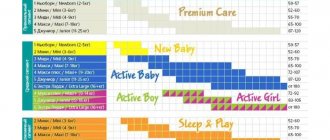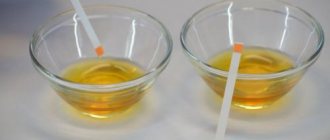Up to 6 months, the child is fully provided with vitamins, minerals, antibodies and all the necessary biological substances contained in breast milk. Particularly important are antibodies that perform a protective and immunomodulatory function in the newborn’s body. Therefore, infants will always be healthier and stronger in comparison with children who, for some reason, are bottle-fed .
The adaptation period to new conditions passes without problems and stress only thanks to frequent breastfeeding and unity with maternal warmth in the process of natural feeding. This is a very important aspect in the formation of immunity, the proper functioning of internal organs and systems, and the development of the skeleton and teeth.
Content:
1. How to understand that it’s time to introduce complementary foods 2. When it is better to postpone the introduction of complementary foods 3. Features of introducing complementary foods to infants 4. Complementary feeding schedules 5. Schedule for introducing complementary foods: where to start 6. Complementary feeding during breastfeeding: input table 7. Tips for preparing meals for complementary feeding 8. Types of cereals for complementary feeding 9. The procedure for introducing porridge into a child’s diet 10. What criteria should porridge meet 11. Prepare porridge yourself or buy 12. How to offer the baby the first meal
How to understand that it is time to introduce complementary foods
The fundamental factor for determining the time to start complementary feeding during breastfeeding is the age of the child. There are a number of rules that allow you to accurately calculate the moment when a baby needs additional complementary feeding.
Among the basic rules, the following should be noted: • the child reaches 4 months of age. In cases of premature infants, calculations should be made by gestational age; • from the moment of birth, the baby’s weight has at least doubled; in those born prematurely, the weight gain should be at least 2.5 times; • the appearance of the baby’s first teeth indicates that, in addition to breast milk, the baby’s digestive system is ready to introduce additional food into the diet; • the child lacks a tongue thrust reflex, which is especially evident in the first months after birth. This reflex protects the baby from accidentally swallowing small objects; • if the child does not eat completely and asks for more; • the baby can confidently be in a half-sitting position, squeeze objects with his hands, consciously tilt his head, refusing to eat, or try to put everything in his hands into his mouth; • the first complementary foods can be introduced when the child has learned to protrude his lower lip and readily opens his mouth when presented with a spoon of food. Such skills greatly facilitate the process of additional spoon feeding; • the appearance of a chewing reflex, in which the child is able to push food deeper into the oral cavity with his tongue; • manifestation of increased interest in the food on the adult’s plate, while the baby strives to taste the contents. In order not to provoke digestive problems, you should not give your baby age-appropriate foods and delay the introduction of complementary foods. Therefore, every mother is recommended to study the basic rules and principles of introducing complementary foods during breastfeeding, follow them and monitor the development of the baby. Some doctors advise introducing the first complementary foods only after the appearance of the first teeth, others say that after 3-4 months you need to add vegetable purees or cereals to the baby’s diet. According to the recommendations of the World Health Organization, complementary feeding can be introduced no earlier than 4–6 months after the baby is born. This allows the child to maintain the stability of the functioning of the digestive system and thus save the energy needed for development and growth that goes into digesting unusual food.
Russian pediatricians in the article “National Strategy for Feeding Children of the First Year of Life in the Russian Federation” in the journal “Pediatrician Practice” explain that up to 4 months of life, a child is not yet prepared to digest food other than human milk or adapted milk formula. By 4 months of age, the initially increased permeability of the mucous membrane of the small intestine decreases, the level of local immunity increases, the baby’s spoon-pushing reflex fades, and he is already able to swallow semi-liquid and thicker food.
If you start complementary feeding later - after 6 months - the child may experience a pronounced deficiency of iron, zinc and other important microelements, and there will be a delay in the formation of skills in chewing and swallowing thick food. And due to the need to quickly introduce an extensive list of products into the diet, the antigenic load will simultaneously increase.
When to introduce complementary foods
Contrary to the traditions of complementary feeding, which was popular during the existence of the USSR, the timing of a child’s first acquaintance with new food has been significantly changed. The early introduction of juices, cereals, and vegetable purees several decades ago was somewhat justified only for children who were bottle-fed, due to the inferior composition of substitute mixtures. The need to return to work after maternity leave contributed to the transfer of children to breast milk substitutes, which were not saturated with essential vitamins and minerals, and the early introduction of complementary foods helped to somewhat compensate for the deficiency of microelements in children. It was popular to use fruit juices (drop by drop) at 2 months, vegetable purees and cereals from three months.
Modern experts categorically state: such complementary feeding at the age of physiological immaturity of the body only brings harm to the child. The composition of breast milk is so complete and rich that it provides a healthy baby with all the necessary substances for up to 6 months, and substitute formulas do not require additions. The concept of early introduction of complementary foods is recognized as erroneous and irrelevant.
Complementary feeding for a child no earlier than 6 months of age is recognized as corresponding to the physiological needs and capabilities of infants, while food does not replace, but only supplements, breast milk (or milk formula) for the next six months. In some cases, the first complementary feeding at 4-5 months as prescribed by the pediatrician is justified. As a rule, such recommendations are based on the dynamics of growth and weight gain and allergic reactions to substitute mixtures. In this case, an early start to complementary feeding is possible, but there must be medical indications for it, and not the desire of parents or other relatives.
The introduction of additional food into a child’s diet at the age of six months is due to the increasing need for protein, vitamins and minerals. Nature provides a unique marker of children’s readiness for food other than breast milk: the appearance of teeth. However, the living conditions of the mother and child, a changed general diet, environmental conditions and diseases can lead to both too early and too late teething in the baby, so experts advise not to focus on this factor, but to follow the general recommendations or prescriptions of the pediatrician.
What are the dangers of introducing new foods to a baby under 6 months of age?
Photo: Es75/Shutterstock.com
Until six months after birth, the digestive system is just beginning to function. The baby’s gastrointestinal tract is capable of processing breast milk or liquids similar in composition to it; any other products require the production of enzymes for digestion, which the baby’s digestive organs are not yet capable of, and compounds unfamiliar to the body, at best, leave the intestines undigested. At worst, new foods can be harmful to the baby, especially infants and newborns. Moreover, the composition of new food can irritate the mucous membrane of the stomach and intestines, creating favorable conditions for the development of gastrointestinal diseases. New components entering the immature body are perceived as foreign agents and increase the susceptibility of the immune system, cause allergic reactions in the form of skin dermatitis, and disrupt the intestinal microflora. At the same time, even microdoses of new food can contribute to the development of negative reactions.
Porridges as early complementary foods, especially those made according to “grandmother’s” recipes - with milk, salt and sugar, also cause significant harm to infants. Cow's milk protein is a strong allergen, and milk is introduced into the diet no earlier than a year. An infant does not need salt and sugar, but porridge as a complementary food introduced before vegetable purees, even at the age of 6 months, is indicated only for children with a discrepancy between the weight index and age. An abundance of carbohydrates consumed without medical indications contributes to the development of a tendency to childhood obesity and the accumulation of excess body weight in adulthood.
When is it better to postpone the introduction of complementary foods?
Not every child is ready to consume additional food other than mother's milk, even when reaching 6 months of age. Every baby has individual characteristics of development, weight gain and, most importantly, readiness to assimilate new foods through the gastrointestinal tract.
There is no need to rush into complementary feeding while breastfeeding in the following cases: • the child was born during a cesarean section, and not naturally; • during the vaccination period; • in the presence of allergic rashes; • during a cold; • with slow weight gain; • when pathologies are detected in the development of the central nervous system; • during the flowering period of allergenic grasses or trees, as well as in extreme summer heat.
You should also delay adding additional foods to your diet if you change your place of residence. The child must first get used to new conditions, and mother's milk will help him with this.
What complications may arise when introducing complementary foods?
The most common complication when introducing complementary foods is functional dyspeptic disorders in the infant. This includes stool disorders, belching and vomiting, abdominal pain, rumbling, and colic. They are due to the fact that the child’s digestive tract is not yet accustomed to the assimilation of new foods. There is no need to worry about this; it will go away on its own over time.
The second common complication is an allergic reaction. Due to the high allergenicity of the child's body, complementary foods are given for 1-2 weeks, a teaspoon at a time - this makes it easier to identify the allergenic product. If a rash, redness or other manifestations of allergies occur, the product is excluded from the diet.
It is important to know! By the end of the first year, the baby must be taught to be independent: given a spoon for grabbing food, taught to feed independently. However, at this time it is important to monitor him, as the child may choke or choke due to insufficiently developed swallowing skills.
Features of introducing complementary foods to infants
Each child needs an individual approach and this should be taken into account before starting complementary feeding while breastfeeding. If the mother eats well during breastfeeding, the baby develops normally and gains weight, and is absolutely healthy, then there is no particular need to change his diet before 6 months.
When deviations in weight gain are observed and the baby’s hemoglobin level is below normal, it is advisable to introduce complementary foods before six months of age. You just need to do this correctly and step by step.
Educational complementary foods
To arouse the baby's interest in new foods is the main goal of educational complementary foods. About a month before introducing complementary foods while breastfeeding, you can let your baby taste different foods. For example, lick a banana or an apple, drop a drop of juice on your tongue, and put vegetable puree on the tip of a teaspoon. After this, be sure to monitor during the day whether the child has any allergic reactions or changes in stool and behavior. If everything is fine, then you can safely continue the preparatory period.
Where to start complementary feeding
Many pediatricians agree that it is best to start complementary feeding with porridge. It is ideal for children with normal and insufficient weight gain relative to age. The first row of cereals includes gluten-free cereals, which do not contain gluten. Rice porridge (especially useful for frequent loose stools), corn or buckwheat are excellent for complementary feeding. The latter is recommended for children with low hemoglobin levels. If the child is overweight, it is better to use vegetable puree as complementary foods. Carrots, cauliflower, potatoes or zucchini are great for this.
Experts recommend using environmentally friendly industrially produced products for the first complementary feeding, which are crushed according to age to the required fractions, enriched with minerals and vitamins, prepared and packaged strictly under sterile conditions.
How to introduce complementary foods: basic rules
There are certain rules for complementary feeding when breastfeeding, the observance of which is extremely important at the initial stage of introducing other foods into the baby’s diet. These rules include: 1. Calendar dates. If the introduction of complementary foods is planned to begin in the winter season or early spring, then vegetable products should be used with extreme caution. The best period for vegetables will be summer or autumn. During the off-season, you should only use products in jars. 2. Diet. When introducing a child to new foods, you need to carefully plan the schedule. The intervals between feedings should be at least 4 hours. 3. Cooked food should be warm, but under no circumstances hot. It should be given to the baby on an empty stomach, and then supplemented with breast milk. 4. It is necessary to feed the child only with a silicone spoon. It will protect sensitive gums from damage and allow the baby to quickly get used to the spoon. The first portions should be alternated with the baby’s usual food – breast milk. 5. It is advisable to start complementary feeding in the morning, which will allow you to monitor the state of the child’s body and its reactions to new foods throughout the day. 6. A new product can be introduced into the menu only for those children who do not have any pathologies. If vaccination has been carried out, complementary feeding can be started no earlier than 3-4 days after the manipulation. 7. You should not try to force your baby to swallow a new dish. If the baby cries a lot and turns his head away, then you should just feed him breast milk. 8. If, after consuming a new product, severe dry skin, the appearance of a rash or upset bowel movements are observed, then it is necessary to temporarily exclude this product from the diet. 9. Only after two weeks have passed can you give the baby a second product after the body has accepted the first. 10. Initially, you should give the child only liquid food and gradually bring the consistency to a thicker state. 11. At the baby’s first request, he should be given a drink, but this should not be done during feeding. 12. The child should be fed new foods strictly according to the schedule.
The main task of the mother when supplementing the diet with new products is to monitor the condition of the stool and skin. If the first complementary feeding during breastfeeding causes even minor complications in the baby’s well-being, then you should immediately seek advice from a pediatrician.
Complementary feeding schemes
Experts have developed special schemes according to which complementary feeding should be introduced during breastfeeding - traditional pediatric and pedagogical.
The first scheme involves the gradual introduction of different foods into the diet. You need to start with half a teaspoon, gradually increasing the daily volume of the product to 100 ml. If a particular product is well accepted by the baby’s body, then after about 10–14 days the next one can be introduced.
Over time, you can completely replace one breastfeeding with another food. When, after such a replacement, the child asks for the breast and is capricious, it means he is not yet ready for a complete replacement of mother's milk. In such cases, you need to combine breastfeeding with complementary feeding.
The principle of pedagogical complementary feeding is based on feeding the baby directly from the parent's plate. Portions should start minimal. The child gets the opportunity to get acquainted with the products consumed by adult family members. However, breast milk should remain the main food until the child reaches at least 12 months of age.
Age up to 1 year
To help mothers, manufacturers offer a wide range of baby food . Pay special attention to the different types of cereals and age restrictions. They are easy to use, stored for a long time (under certain conditions), quickly prepared, and absolutely safe for children’s health.
When breastfeeding, monthly complementary foods for infants until they one year of age should exclude milk from goats and cows . Oddly enough, the baby does not have enzymes to process them.
From 9 months to 12 months of age:
- fruits (up to 100 g);
- fruit juice (up to 100 g);
- vegetable puree (up to 200 g);
- rice, buckwheat porridge (up to 200 g);
- cottage cheese (40 g/45 g);
- boiled chicken yolk (1/2 part);
- boiled meat crushed into puree (60 g);
- steamed fish puree (30 g/70 g);
- fermented milk products (150 g/300 g);
- butter (6 g);
- cookies (biscuits), crackers (5 g/15 g);
- white bread (5-10 g).
Feed 3-4 times a day. For the first year of life, the baby should only take porridge cooked in water. It is unacceptable to introduce gluten-containing products (wheat cereal, etc.).
From 10 months onwards, complementary feeding is given 4 times a day . In addition to a piece of apple, prunes and pears (total weight up to 100 g) are added as a snack, and a compote is made from them.
Complementary feeding schedule: where to start
There is no exact time frame for when to start complementary feeding while breastfeeding. In this regard, you need to be guided only by the individual characteristics of the child.
Pediatricians also differ in their opinions on which products are best to use for first complementary feeding. Some recommend vegetable purees, others are sure that there is nothing better than porridge.
Along with the diversity of opinions, modern pediatrics, represented by the World Health Organization, has unquestioningly established the main rule - do not start complementary feeding with juices. They have an aggressive effect on the digestive system, so WHO does not recommend giving them to children under one year of age. It is also undesirable to use fruit purees as the first additional products due to the high content of various acids and sweetness in them, which the baby quickly gets used to.
Most pediatricians agree that the correct first complementary foods are vegetable purees, which are gradually replaced by gluten-free and dairy-free cereals.
According to the “Program for Optimizing Feeding of Children in the First Year of Life in the Russian Federation,” approved in 2020, it is quite easy to make a choice between porridges and vegetable purees: if the child is underweight or has frequent stools, commercially produced porridge is preferable as the first complementary food; if the child is overweight and constipation - vegetable puree.
It is better to start vegetable feeding with one-component purees. In the first half of a child’s life, you can introduce fruit puree into the diet, and then meat puree, since it contains a lot of easily digestible iron. From 7 months of age, yolk is added to the diet, and from 8 months, fish puree is added. Kefir, yogurt, biolact are introduced into the diet no earlier than 8 months of age, at which time you can add baby cottage cheese.
Since the digestive system of a baby under one year of age is not ready to digest the coarse casein proteins contained in goat or whole cow's milk, porridge should be prepared in water. For example: human milk contains 18% casein, and in cow's milk this component reaches 82%.
Porridges should be gluten-free because gluten belongs to the group of potential allergens. The enzyme that breaks down gluten begins to be produced in the child’s body a little later. Gluten porridges include barley, semolina, pearl barley, and oatmeal.
The ideal choice for the first complementary feeding would be porridge made from buckwheat and rice. To do this, you can use ready-made baby food or carefully grind the grains to flour and cook the porridge with a liquid consistency. Such cereals are especially useful for children who do not gain weight well.
Monthly meal plan
Complementary feeding for a baby by month while breastfeeding
Below is a breakdown of complementary feeding for a baby by month while breastfeeding . Now let's start with the little ones from 0 to 6.
A newborn baby can breathe, sleep, announce a stimulus by screaming, suck and swallow. He needs to learn everything else, including digesting mother's milk. He can consume only liquid food without risk to life and health.
The mother must adhere to a nutritious diet - the baby will receive a sufficient amount of useful substances with milk, adapted to the baby’s digestion. Before reaching 3 months of age, it is strictly forbidden to feed the baby. Suitable for breastfeeding, water/dill water.
Who trusts the instructions of USSR doctors: from 3 months of age (monitor the baby’s reaction), it is allowed to add green apple juice to the water, starting with 2 drops/day and adding 1 drop daily to the previous dose, reaching 1 teaspoon. After this, you don’t have to dilute the juice.
Today, doctors recommend supplements from raw fruits (juices, purees) to be shifted to 5.5-6 months of age , but according to the same schedule.
Complementary feeding from 4 to 6 months is administered only as prescribed by the doctor.
4-6 months
about four months of age, the baby masters chewing skills , the strength of biting and sucking is more often observed, and the gag reflex shifts from the middle to the root of the tongue.
When breastfeeding, complementary foods are introduced to infants after reaching a full 6 months (normal). Additional nutrition from 4 to 6 months. administered only as prescribed by a doctor.
Until six months, the child’s food is not seasoned with spices, sugar, or salt. For children under six months of age, only pureed foods with a liquid consistency . First, they are taught to eat vegetable products, then fruits, and finally porridge is introduced , unless the doctor has prescribed otherwise. The food is prepared fresh every time.
From 4 months of age, they are fed 1 time per day , right before breastfeeding (the rule applies for the entire subsequent period). You can already get apple juice, gradually get used to banana and zucchini puree, starting with a quarter of a teaspoon and reaching up to 30 grams.
You can't add potatoes. Fruit varieties that contain red color cause diathesis in babies. They begin to be given closer to the year.
From 5 months of age, the weight of a portion of fruit products is increased to 50 grams, vegetable purees - a maximum of 150 g. Rice and buckwheat porridge are made in water, beaten with a blender, and given at first 10-50 grams.
By month, vegetable (fruit) complementary foods are given to infants separately. When breastfeeding, two- and three-component dishes are introduced after the baby’s gastrointestinal tract gets used to these ingredients separately . Carrots (every 4 days), cabbage (broccoli, cauliflower), pumpkin are introduced last.
From 6 months of age:
- fruit food – 60 g;
- vegetable food – 170 g;
- porridge (rice, buckwheat) – 150 g;
- cottage cheese (5 g/15 g).
If you start feeding your baby from the age of six months, the weight and type of food must correspond to the specified list in this article for 4-month-old infants. It will automatically shift by two months and the entire subsequent schedule.
Doctors consider it normal to start feeding infants from six months of age, if the mother has sufficient fat content and milk volume.
Among fermented milk products, infants are allowed cottage cheese - from 6 months and kefir - from 8 months
7-8 months of age
The child develops the following skills: bites; chews; the tongue moves food closer to the teeth; cleans the spoon with sponges.
For seven-month-old children, the serving weight does not exceed:
- fruit juice and puree (70 g each);
- vegetable puree (180 g);
- porridge, including corn porridge (150 g/170 g);
- cottage cheese (15 g/30 g);
- Boiled quail or chicken yolk (several grains/¼ part) is given 2 times a week in the morning, added to porridge;
- biscuits, crackers (5 g).
In complementary feeding for breastfed infants, from the age of seven months, they begin to gradually introduce chopped or grated food (vegetables, fruits) into the diet, alternating with purees, kefir (5-100 grams), butter (start with 1 gram per day) .
Meat is allowed for babies from 7 months of age
For 8-month olds the diet is:
- fruits, juice (80 g each);
- vegetables (190 g);
- porridge (170 g/180 g);
- cottage cheese (30 g/40 g);
- boiled yolk (1/4 – 1/2 part);
- boiled dietary meat crushed into puree (5 g/30 g) is given for lunch, pork should not be introduced into the diet until the age of 1.5 years;
- butter (4-5 g);
- crackers, biscuits (5 g);
- fermented milk product (150 g);
- white bread (5 g).
They are fed 3 times during the day , first fed with cooked food, then supplemented with breastfeeding. As for vegetables, mashed potatoes of a semi-liquid consistency are added to the diet.
Meat: turkey, rabbit, lamb, chicken, veal, beef (observe the order).
Complementary feeding during breastfeeding: input table
Pediatricians and WHO specialists have developed special schedules regulating the list of foods introduced into the diet and complementary foods by day. This table of complementary feeding during breastfeeding by month is one of the schemes approved by leading Russian pediatricians and WHO.
| Child's age | Complementary feeding products | Consistency of the dish | Features of feeding |
| 6 months | Cauliflower, zucchini, potatoes grown without the use of chemicals and growth stimulants. | Liquid, not exceeding the consistency of sour cream. | Monopure is prepared without adding salt. You should start with 2-3 g per day, increasing the volume to 2 tablespoons over the course of a week. If there are no complications in the future, you can mix two types of vegetables in puree. |
| 7 months | Unsalted, gluten-free porridge prepared with water (or breast milk) from corn, rice or buckwheat flour. If the baby is lagging in height and weight, then porridge can be introduced into the additional diet before vegetables. | The consistency is puree-like. | The child should be given one teaspoon of porridge 1-2 times a day. Until the end of the week, the portion is gradually increased to 3 tablespoons, and until the year is reached, the volume should be 150 ml. |
| 8 months | Lean meats: pork, rabbit, veal, chicken. | Foods processed in a blender or mashed to a puree consistency. You can mix a quarter of chicken yolk into ready-made dishes 1-2 times a week. | Before chopping, the meat is first boiled and given to the baby with a side dish. You need to start with ½ spoon, increasing the volume to 30–50 g per week. |
| Cottage cheese and yoghurts. | Fermented milk products are introduced very carefully. By the age of one year, a child should receive 150 g of kefir or 100 g of cottage cheese per day. | ||
| 9–11 months | Oatmeal, chicken yolk, crackers, bread and fish (trout, hake, cod, flounder). | Puree consistency. | Fish should be included in the complementary feeding menu during breastfeeding with 5 g, gradually increasing the volume to 100 g. You can prepare meatballs from fish, which go perfectly with a side dish of porridge or vegetables. |
| 12 months | Vegetable and fruit juices. At first, single-component ones from peaches, green apples, apricots, plums. In the future, mixing several products is allowed, for example, an apple with carrots or apricots. | Chopped products without added sugar and salt. | Juices should be given to children starting from 0.5 teaspoon. Up to a year, the portion increases to 100 g. |
Detailed description of complementary feeding for children under one year old
Baby is 6 months old
Breastfed babies are introduced to first courses of vegetables. The exception is children who do not gain weight. In this case, the porridge is added first.
The first vegetable that can be used to make puree is zucchini , as it is a hypoallergenic product. Give 0.5-1 teaspoon on the first day, then increase every day by 2-3 spoons. If the body reacts normally, on day 7 the baby can eat up to 100-150 grams of complementary foods.
Then add the pureed creamy cauliflower puree. After a couple of days, you can mix the two vegetables if there were no reactions to either of them. Each vegetable is introduced separately and only then added to the vegetable puree.
Pumpkin and carrots are introduced carefully and as a last resort, since these vegetables quite often cause an allergic reaction in young children.
After introducing complementary foods, mothers always observe changes in the consistency and color of the child’s physiological functions. This is normal and is due to changes in diet and imperfect fermentation. In the first days, food may come out even half undigested, or with elements of mucus and greens. Within a week everything will return to normal without medical intervention.
Baby 7 months old
At this age, the child already actively eats from a spoon 2-3 times a day and has preferences in dishes. You can put him in a special high chair, where he feels confident and eats food with pleasure. At this age, according to the complementary feeding table by month, you can add porridge.
Experts recommend using buckwheat, rice and corn cereals.
Now stores offer a huge selection of cereals for children under one year old. Such porridges are already prepared for the child to eat without additional chopping, which is very convenient. To prepare them, just add boiled water to the desired consistency.
If your baby refuses to eat porridge without milk, you can add breast milk. Cow's and goat's milk are strictly prohibited for children under one year of age, as they negatively affect the digestive organs, in particular the small intestine.
Complementary foods are introduced at this stage according to the same scheme as vegetables. It is recommended to give porridge in the morning.
Age 8 months
At the age of 8 months, the baby can already eat quite a varied diet, because at this time several new foods are introduced. Most of the food intake in the form of breast milk is replaced with a variety of complementary foods.
Potato
This month the diet increases and meat, egg yolk and potatoes are added to it. Potatoes are an allergenic product containing large amounts of starch. Therefore, it is recommended to introduce it into complementary foods later than other vegetables. The first times of administration are 10-15 grams, that is, 2-3 teaspoons separately from other products. Then introduce incrementally, but not more than 50-80 grams per day.
In vegetable puree, the amount of potatoes should not exceed a third of the total volume.
Turkey and rabbit
For meat complementary foods, it is best to use turkey and rabbit, because they are considered the most healthy and are easily absorbed by the child’s body. Chicken and veal can be introduced after a couple of months. Beef is recommended from year to year.
Meat puree is administered in an amount of 5 grams along with vegetables, preferably for lunch. After a month, the child should eat 50-60 grams of meat. And by the age of one year, the daily menu should contain up to 100 grams of meat. It is very important to mix it with vegetables for good absorption.
Egg yolk
Introducing complementary foods for babies according to the table is considered the best decision for all mothers, as the risk of frequent allergic reactions is reduced. For example, egg yolk is the most allergenic product, so it is introduced literally in crumbs . Preference is given to quail eggs, but chicken eggs are also allowed if the reaction is normal.
It is recommended to give the yolk no more than 2 times a week. A couple of weeks after the introduction of small parts of the yolk, it is allowed to give the baby half a quail and a quarter of a chicken. It is better to mix this product with porridge or grind it with milk, and feed the child in the morning.
Baby is 9-10 months old
Cottage cheese
At 9 months, fermented milk products are included in the menu. Cottage cheese should be low-fat, without added sugar. It needs to be rubbed well through a special sieve or using a blender to turn it into a homogeneous mass without lumps. You need to start with 5 grams and gradually increase to 30-40 grams. By the age of one year, a child should eat up to 80 grams 3-4 times a week.
Kefir
Kefir is taken for children, without additives. It can be purchased at pharmacies or specialized baby food stores. Start with 10 milliliters and increase to 100-150 ml per day. It is better to feed in the evening before dinner, about 2 hours before. Can be alternated with cottage cheese.
Ban on sweeteners
Some children deny fermented milk products due to the presence of a sour taste, but it should be remembered that sweeteners are strictly prohibited , so you need to set them aside for a while and repeat a little later.
Tips for preparing complementary foods
A rather responsible process is the introduction of complementary foods during breastfeeding. Only freshly prepared meals can be given to the child using special dishes. It is extremely undesirable to feed your baby with your own spoon and from your own plate.
To avoid possible problems with the absorption of foods, you should be guided by several simple principles: • select only young vegetables and organic products for complementary feeding; • it is best to feed a new dish in the morning during breakfast and always before breastfeeding; • products should be introduced one at a time, starting with minimal doses. In this case, you need to observe the reaction of the body that has not yet become stronger for 12 hours; • if negative reactions occur, the unsuitable product must be discontinued immediately; • increase the volume gradually and smoothly, taking into account age; • you should not stop breastfeeding even in cases where the baby likes “adult” food.
After the child gets used to the porridge, you can add a little butter to it. It is strictly forbidden to give your baby exotic fruits, mushrooms, nuts, honey and regular tea before one year of age.
1-2 years of age
Table for the introduction of complementary foods to breastfed children in the first year of life.
Complementary feeding for infants by month during breastfeeding should be a complete list of adult foods . The child already knows how to eat a variety of foods, therefore, he needs to gradually introduce other foods.
You can start giving whole milk (50 g/200 g), wheat and pearl barley porridge, beans, peas, dried apricots . Definitely, food should not be fried, smoked, pickled, or salted.
A children's diet up to two years of age includes only boiled, steamed, stewed, and baked food in foil . Tropical fruits are not recommended.
The mother can continue to breastfeed the baby.
Types of cereals for complementary feeding
Porridge is a necessary and very important dish in children's nutrition. Their benefits are great and consist of the following: • cereals contain a large number of useful elements, the porridge itself has a beneficial effect on the baby’s digestive system; • the porridge contains the amount of proteins necessary for a child, as well as vitamins belonging to group B; • cereals are a powerful source of healthy carbohydrates necessary to saturate a small body with energy. Porridges also have high nutritional value.
When complementary feeding begins while breastfeeding, it is better to use store-bought cereals for this. They come in several types: • dairy and dairy-free; • gluten-free and gluten-containing; • fermented milk; • hypoallergenic; • single-component and multi-component.
There are also special therapeutic and preventive porridges on sale, which contain pro- and prebiotics and well restore the balance of intestinal microflora.
The procedure for introducing cereals into a child’s diet
Before introducing complementary foods while breastfeeding, you need to make sure that the baby is completely healthy and does not have any hidden pathologies. Vegetables or cereals can be given to a child from 5-6 months before breastfeeding. The diet should be planned so that one feeding is subsequently completely replaced with additional products.
Porridge should be introduced into the baby's diet in the following order: • feed the child freshly prepared porridge every day for breakfast. Cook without sugar or salt. At first the consistency should be slightly thicker than breast milk, later you can prepare thicker mixtures; • during the first week, give your baby buckwheat porridge. Start with one teaspoon. If there are no negative reactions on the second day, the amount of porridge can be increased to 2-3 spoons. On day 4, you can make the consistency thicker and let the child eat 5 spoons. By the end of the week, the daily portion should be 100 g, the consistency should resemble a creamy porridge; • during the second week, prepare rice porridge and feed the child according to a similar scheme as with buckwheat. It is also possible to alternate rice and buckwheat every day; • in the third week, corn flour porridge is prepared for complementary feeding, following the schedule described above; • starting from the fourth week, you can include oatmeal in the menu. But here it is necessary to carefully monitor the baby’s reaction, since oatmeal contains gluten.
Corn grits porridge is considered a valuable product. It contains a lot of protein, microelements and fiber. It is best to introduce it after buckwheat and rice. There is no need to rush with semolina; some experts advise giving it to a child only after a year.
When should you start feeding your baby?
Often grandmothers advise mothers to introduce complementary foods to their children before six months, starting from the age of three months. The main thing a mother must do is not to give in. Previously, children actually began to be fed very early, but numerous studies prove that this is wrong and early complementary feeding can affect the proper functioning of the child’s gastrointestinal tract. WHO recommends that a child should be exclusively breastfed or formula fed until he reaches six months of age. Until this point, the baby has absolutely no need for other food, especially one who is exclusively breastfed.
Why is it still not recommended to introduce complementary foods before six months?
It has been proven that early complementary feeding is not beneficial and even harmful to the baby. The body of a child younger than six months does not yet produce enzymes capable of digesting new “adult” food. And even if the mother nevertheless decides to give the child complementary foods, it simply will not be absorbed into the small body, and perhaps even harm it. Undigested food will create extra stress on the baby's digestive system. Even a few teaspoons will make a significant difference. There is no need to rush into this matter.
It is believed that children fed formula produce the necessary enzymes earlier than those children who are breastfed.
For any type of feeding, there is one golden rule - absolutely any product new to the child must be given to him gradually, starting with just one teaspoon. If there are no reactions to the new product, you can slowly increase the daily dose and within seven days the serving size should reach 150 grams.
What criteria should porridge meet?
For the first feeding, it is important to choose the right foods. Porridge should not cause discomfort. To do this, you need to know what criteria it must meet.
Composition of cereals.
At the initial stage, you need to prepare porridge from one grain. This will allow you to control how the child’s body reacts to the new product. Only if there are no side effects can you start preparing porridge from several different grains.
Presence of gluten.
These include wheat, oatmeal, barley and semolina porridge. It is important to be aware of the possible risks here, since such dishes can provoke allergic reactions at an early age.
Milk content.
When can you start complementary feeding while breastfeeding cereals? No faster than from the age of 5–6 months. And you need to start with dairy-free cereals. Cow's milk is still an undesirable product because it belongs to the group of strong allergens.
Some mothers prepare porridge using their own breast milk or using special milk formulas. This solution is optimal.
Complementary feeding at 5 months
Boiled vegetables or dairy-free porridge are chosen as the first complementary foods.
- If you start with dairy-free porridge, then this porridge, as a rule, complements the second meal (second breakfast).
- If you start with vegetable purees, then they are introduced for lunch.
After two weeks, cereals can be cooked in milk (preferably breast milk). Preference is given to buckwheat, rice or corn cereals, as they are less allergenic. At first, it is recommended to prepare vegetable puree from zucchini. Next, it is made from carrots, broccoli, and cauliflower.
Read also:
Answers to the most important questions about feeding young children
After 2 weeks from the start of the first complementary feeding, the introduction of the second complementary feeding begins, the opposite of the one with which they started. Thus, if you started with vegetables, introduce porridge and vice versa.
After another 5-7 days - the third complementary food in the form of fruit puree, which is added to breakfast along with milk porridge. After another week, fruit juice is introduced for lunch.
Thus, at the 5th month of life, four complementary foods are sequentially introduced (porridge, vegetables, fruit purees and fruit juice). The diet of a five-month-old baby is as follows:
| Age | Menu by number of meals |
| 5 months: 1-14 days | 1 - Breastfeeding 2 - Dairy-free (buckwheat, corn, rice) porridge (1-2 tsp) + breast milk 3,4,5 feeding: Breastfeeding |
| 5 months: 15–19 days | 1 - Breastfeeding Second breakfast: Milk porridge 150 gr. +mother's milk 2 - Liquid monocomponent zucchini puree (1-2 tsp) + breast milk 4.5 feeding: Breastfeeding |
| 5 months: 20–24 days | 1 - Breastfeeding 2 - Milk porridge (150 gr.) + monocomponent fruit puree (1-2 tsp) 3 - Vegetable zucchini puree 150 gr. + mother's milk 4.5 feeding: Breastfeeding |
| 5 months 25 days – 6 months | 1 - Breastfeeding 2 - Milk porridge (150 gr.) + monocomponent fruit puree (50 gr.) 3 - Zucchini puree 150 gr. + fruit juice (1-2 tsp) 4.5 feeding: Breastfeeding |
| Between feedings, baby drinking water in a volume of 50-70 ml (up to 150 ml). | |
Prepare porridge yourself or buy it
We have figured out when to introduce complementary foods during breastfeeding, but many mothers ask themselves another question: whether to prepare their own porridge or whether it is better to use store-bought ones. Certain advantages are characteristic of both options and you should be guided in this direction only by your own preferences.
If we talk about finished products, then among the advantages we should note: • saving time. Mom doesn't need to waste time standing at the stove. Just add water to the mixture, stir and the dish is ready to eat; • quality. Very high demands are placed on baby food manufacturers. Before products enter the market, they are carefully checked and certified. At the same time, mixtures for preparing porridges are completely tailored to the age and needs of the baby; • variety of choice. A variety of types of cereals are offered for sale today. This allows you to choose the most suitable product for each child.
In addition to choosing one type of porridge or another, you also need to prepare it correctly. For the first complementary feeding, it is prepared as follows: • diluted with water or milk formula, depending on whether milk is present in the composition or not; • you need to pour 5 g of cereal into a container, add 0.5 cups of water, stir thoroughly until the mixture has a liquid consistency (unless otherwise specified in the instructions); • subsequently the amount of cereal gradually increases to 10 g; • to prevent lumps from forming in the porridge, it must be mixed well immediately after adding water; • water for dilution should be boiled, but not too hot. If you add boiling water, then along with the formation of lumps in the finished dish, beneficial elements and vitamins will be disrupted.
When buying porridge in a store, you need to carefully study the packaging. It must be intact and hermetically sealed. Be sure to check the expiration date. Do not buy products that contain potentially hazardous substances. The packaging should also have a mark indicating the age at which you can start giving this product.
How to offer your baby his first meal
The first feeding should be gradual. We must not forget that breast milk remains the main product in a baby’s diet. This is also noted by the famous TV doctor E. O. Komarovsky. The new dishes introduced to the menu are only a small addition to breastfeeding.
You should also prepare in advance for complementary feeding. To do this, you need to buy a special baby spoon made of silicone or safe plastic. Spoons with temperature indicators will be very convenient for feeding. When the temperature of the dish exceeds 40 °C, the spoon changes color.
The main purpose of complementary feeding is not to simply feed the baby. First of all, you introduce your child to new tastes. After each new meal, be sure to put the baby to the breast.











